|
< Earlier Kibitzing · PAGE 9 OF 12 ·
Later Kibitzing> |
| Feb-22-12 | | Absentee: <Once: <Dom> I suspect that "must of" is one of those phrases which is on the cusp of changing from "ever so wrong" into something that is perfectly acceptable.> With any luck, the world's gonna end before that. |
|
| Feb-22-12 | | YoungEd: Just imagine the adrenaline flow the players must have felt during the game! This is one of the most exciting games I have ever seen; I've played it over many times and enjoy it equally every time. |
|
| Feb-22-12 | | Once: <Absentee> December 2012, if the Mayans are to be believed. On a Wednesday. At a quarter past three, GMT. That's the end of the world, not when "must of" becomes accepted. Then again, maybe the two are the same thing ... |
|
| Feb-22-12 | | Shams: I make a special point to be a prick when people use "of" as a verb. |
|
Feb-22-12
 | | Penguincw: < Penguincw: <cg> should start repeating puns. > What I meant to say where <cg> should stop repeating puns. To the Pun Submission Page and Pun Voting Booth! |
|
Feb-24-12
 | | Domdaniel: <Once> Well, yes. As a semi-trained linguist, I try not to be horrified at anyone's use of language -- just note it as a trend and pass on. And you could be right to say that 'must of' is now so ubiquitous as to be standard. But split infinitives were never really wrong: they came to be seen as incorrect when 18th century grammarians tried to retroactively apply the rules of Latin to English. 'Must of' is one of those that I find regrettable because it loses touch with the syntax of the original 'must have'. Maybe something like 'mustev' would pass muster. BTW, I found a few of your magazine articles. Very innaresting. |
|
Feb-24-12
 | | Domdaniel: <Shams> - < I make a special point to be a prick when people use "of" as a verb.> Heh. I would of had of a debate with you, but instead I could of just said "of off!". |
|
Mar-23-12
 | | AylerKupp: The Immortal Draw (Part 1 of 8, Spike 1.4 part 1)
In chessgames.com chessforum <chessgames.com> asked if anybody had any comment on <sofouuk>'s analysis using Rybka (not Houdini as indicated in <chessgames.com>'s comment) and whether the Immortal Draw had really been debunked. This exercise turned out to be a lot more involved than I anticipated, but here are some Spike 1.4, Stockfish 2.2.2, Houdini 1.5a, and Rybka 4.1 additional analyses, and some thoughts of my own. I'll let you decide for yourself whether the Immortal Draw has been debunked or not. <sofouuk> indicated that in the position after 10...Nc5 that Rybka evaluated 11.Kb5 instead of 11.Kb4 as probably advantageous for White and possibly even winning.
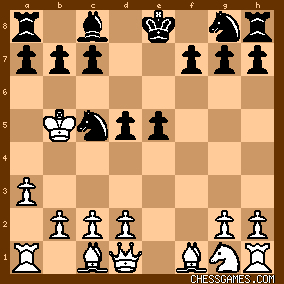
click for larger viewThis is how Spike 1.4 evaluates the position: [+1.03], d=33: 11...Ne7 12.c4(1) d4 13.Kxc5 a5 14.Qa4+ Kd8 15.Qxa5(2) Rxa5+ 16.Kb4 Nc6+ 17.Kb3 Be6 18.d3 b5 19.Bd2 Ra7 20.Nf3 f6 21.Re1 Re8(3) 22.Ka2 Kd7 23.Rd1 Rb8 24.b3 bxc4 25.bxc4 Nb4+ 26.Bxb4 Rxb4 27.Nd2 Rba4 28.Nb1 Kd6 29.Re1 f5 30.g3 c5 31.h3 h5 32.Ka1 g6(4) 33.Bg2 Rxa3+ 34.Nxa3 Rxa3+ 35.Kb2 Rxd3(5)
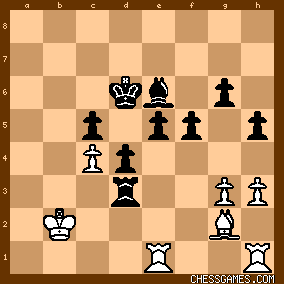
click for larger view(1) The obvious 12.Kxc5 results in a draw similar to the game after 13...a5 14.Bb5+ Kd8 15.Bc6 b6+ 16.Kb5 Nxc6 17.Kxc6 Bb7+ 18.Kb5 Ba6+ 19.Kc6 Bb7+ (2) As <sofouuk> and Rybka indicated, White must give back the queen to survive. If instead 15.Qb5 then 15...b6+ 16.Qxb6 (forced) 16...cxb6+ 17.Kxb6 Bf5 and material is even, Black has lead in development (an understatement), and White's king is somewhat exposed (an even bigger understatement!).

click for larger viewSpike evaluates this position at [-5.66], d=28 after 18.Nf3 Rb8+ 19.Kc5 f6 20.Nxe5 (20...Kd7 followed by 21...Rhc8# was threatened and White has to make some squares available for his king) 20...fxe5 21.Kd6 Ng6 22.c5 Rf8 23.Kd5 Kc7 24.b4 Be6+ 25.Ke4 (25.Kxe6 Nf4#) 25...axb4 26.axb4 Rxb4 27.g3 Bf5+ 28.Kf3 Bh3+ 29.Ke2 Bxf1+ 30.Rxf1 d3+ 31.Kxd3 Rxf1 32.Bb2 Rxa1 33.Bxa1 Kc6 34.Bc3 Rg4 35.Ke3 Kxc5 36.Kf3 Ra4 37.h4 e4+ 38.Ke3 and Black's win is not in doubt.

click for larger view |
|
Mar-23-12
 | | AylerKupp: The Immortal Draw (Part 2 of 8, Spike 1.4 part 2)
Better for White (relatively speaking) and humorous besides is 15.Qc6 (echoing the game's 14.Bc6; White must still give up the queen) 15...Nxc6 (15...b6+ transposes to the line above with even better opportunities for Black) 16.Kd5 f5 17.c5 Re8 18.Kc4 e4 (the Black pawns keep cutting off the White king's escape squares) 19.Kb3 d3 (talk about entombed bishops! One seldom sees both bishops entombed in one game) 20.Ka2 Be6+ 21.Kb1 Nd4 22.Nh3 Nb3 23.Nf4 Nxa1 (23...Bf7 might expose White's predicament even more) 24.Kxa1 (24.Nxe6+ eliminating one troublesome Black piece might be better) 24...Bf7 25.g3 Re5 26.Bg2 Rxc5 27.h4 g6 28.g4 a4 29.gxf5 gxf5 30.Nh3 Rb8 (here 30...h3 preventing 31.Ng5 seems better) 31.Ng5 Ke7 32.Bh3 Ra5 33.Nxh7. Spike evaluates this position at [-3.02], d=24.

click for larger view(3) Perhaps 21...Kd7 followed by 22...Rb8 would have saved a tempo and prevented 24.b3 followed by 25.bxc4. (4) If Black is planning to advance his pawns then 32...g5 is certainly more aggressive. (5) <sofouuk> said of an earlier position (after Rybka's 22.Kc1, see below), "black's central passed pawns and development mean the game continues, but its clearly advantage white". But here with 4 pawns for the rook (either White's Pc4 or Pg3 is about to fall), White's advantage is neither so clear nor so great, even though White now has open files for his rooks. It reminds me of one of my favorite Tal games: Portisch vs Tal, 1964. And, in fact, starting from this position, Spike evaluates it at [-2.34], d=27 after 36.Bf1 Rxg3 37.Ra1 e4 38.Ra6+ Ke7 39.Ra5 f4 40.Rxc5 Kf6 41.Ra5 f3 42.Ra1 (White has spent too much time moving one rook and neglecting the other rook) 42...Ke5 43.Rh2 e3 44.c5 Bd7 45.Ra7 Bf5 46.c6 Rg1 47.Ra1 Kd6 48.Rd1 d3 (if 2 connected passed pawns on the 3rd rank beat a rook then 3 connected passed pawns on the 3rd rank . . .) 49.Kc3 d2 50.Rhxd2+ exd2 51.Kxd2 Rg3 52.Rc1 Bxh3 53.c7, a likely win for Black after 53...Bc8
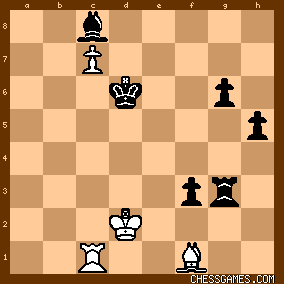
click for larger view But Spike sure makes it complicated and exciting! And Spike, ever the joker, suggests that if 53...Be6 then 54.a8N+ (a most unusual spite check!) Bxc8 55.Rxc8 and [0.00].

click for larger view |
|
Mar-23-12
 | | AylerKupp: The Immortal Draw (Part 3 of 8, Stockfish 2.2.2)
This is how Stockfish 2.2.2 evaluates the position after 11.Kb5: [+1.09], d=37: 11...Ne7 12.c4 d4 13.Kxc5 a5 14.Qa4+ Kd8 15.Qxa5 Rxa5+ 16.Kb4 Nc6+ 17.Kb3 b5(1) 18.Nh3(2) Ke7(3) 19.d3 bxc4+ 20.dxc4 Bxh3(4) 21.gxh3(5)
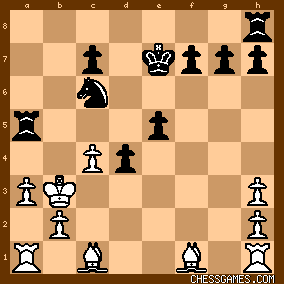
click for larger view(1) Up to here it's the same as Spike. Spike opted for 17...Bb6 and I'm not sure which is better, although I wouldn't be unhappy with Black's position in either case. (2) Developing the knight away from the center can't be right. Nh3-f2-e4 is too slow as is Nh3-g5-e4, and the knight can always be kicked away by f7-f5. (3) 18...f6 followed by 19...Be6 putting additional pressure on the Pc4 (if d2-d3, ...e4) might be worth looking into. (4) I think that 20...Bf5 cutting off the king's retreat and getting the other rook into the action is better. How does White deal with 21...Rb8+ 22.Ka2 Nb4+ 23.Kb3 Nc2+ 24.Ka2 Nxa1 Kxa1 and Black is a pawn and the exchange ahead. Of course, if Black has his heart set on a draw (although non-immortal), there's always 24...Nb4+ 25.Kb3 Nc2+ etc. ļ (5) Black effectively has 2 pawns for the piece, the more active pieces, and 3 connected passed pawns ready to start charging down the board so I disagree with Stockfish's evaluation, even though White has those 2 bishops and open diagonals for them. But Stockfish sticks to its guns. Starting from this position, Stockfish evaluates it at [+1.25], d=30 after 21...e4 22.Bf4 Rc8 (somewhat passive. I don't think that the game will be decided by Black's c-pawn! And, given how the remainder of the line goes, 22...Ra7 would have saved 2 tempos) 23.Rd1 g6 24.h4 f5 25.Kc2 Ra4 26.Be2 Kf6 27.Rhe1 Ra7 28.Rg1 Ra4 29.Rge1.

click for larger viewWell, those bishops sure look strong but so do those 2 connected passed pawns. And Stockfish doesn't seem to know what to do at this point for either side, as evidenced by its last 2 moves for Black and White. Black could try 29...d3+ 30.Bxd3 exd3+ 31.Rxd3 Rxc4+ 32.Rc3 Rxf4 33.Rxc6+ Kf7

click for larger viewAnd Black will go up a pawn, at least temporarily, with either 33...Rxh4 or 33...Rf2+. And if 34.h5 then 34...g5 and Black once again has 2 connected passed pawns, although his c-pawn is extremely vulnerable and will likely fall. I don't know who would win this endgame or whether it would end in another non-immortal draw, but Stockfish suggests the latter, evaluating the position at [0.00], d=27 after 34.h5 Rf2+ (Stockfish chooses to go after the less advanced h-pawn. Go figure) 35.Kc3 Rxh2 36.hxg6+ hxg6 37.Rd1 Re8 (giving up the extra pawn with check ?!) 38.Rd7+ (which White doesn't take!) 38...Re7 39.Rxe7+ Kxe7 40.Rxg6 f4 (giving up a pawn in order to get the f-pawn moving) 41.Rg7+ Kf6 42.Rxc7 f3 43.Kd4 Rxb2 and this is a draw per the Nalimov tablebases.
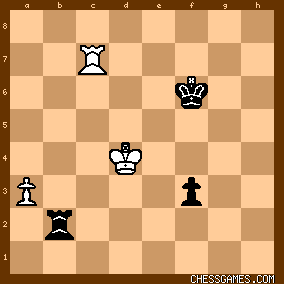
click for larger viewAn interesting and instructive endgame showing the virtue of aggressiveness by both sides. |
|
Mar-23-12
 | | AylerKupp: The Immortal Draw (Part 4 of 8, Houdini 1.5a)
A tiebreaker is needed so let's see how Houdini 1.5a evaluates the position after 11.Kb5: [+1.01], d=27: 11...Ne7 12.c4 d4 13.Kxc5 a5 14.Qa4+ Kd8 15.Qxa5 Rxa5+ 16.Kb4 Nc6+ 17.Kb3 Be6 18.d3 b5 19.Bd2 bxc4+(1) 20.dxc4 Rb5+ 21.Kc2 Bf5+ 22.Kc1(2) Rb3 23.Be2 e4 24.Bd1 Rb8(3) 25.Bf4 d3 26.b4 Ra8 27.Kb2 Kd7 28.Nh3 Bxh3 (again, I don't see why Houdini has Black giving up its well-placed bishop for White's ill-placed knight which isn't going anywhere. Either 28...Rhe8 to try to advance the e-pawn, 28...Be6 to clear the way for the advance of the f-pawn, or 28...h6 restricting the knight's and bishop's movement and preparing ...g5 to kick the bishop seem better.) 29.gxh3 f5 30.Kc3 h6 31.b5 Nd8 32.Be3 Ne6(4)
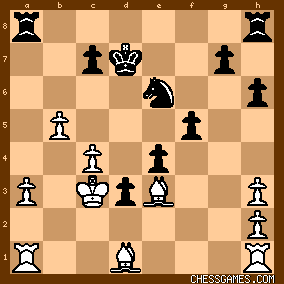
click for larger view(1) Up to here it's the same as Spike. Spike opted for 19...Ra7 which I tend to prefer since it maintains the tension but I think that the lines transpose into each other. (2) And up to here it's identical to the line that <sofouuk> gave for Rybka on Jan-10-12, although I'm not sure why neither Rybka nor Houdini opted for 22.Bd3 since, with the Bf5 and the Rb5 under attack, I don't see anything better for Black than 22...Bxd3+ 23.Kxd3 Rxb2. Let's see if Houdini evaluates the line as "clearly advantage white" as <sofouuk> indicated. And, given that Rybka's and Houdini's analyses are exactly the same after 22 plies, hopefully no one will accuse Rybka 4.1 of being a clone of Houdini 1.5a or vice versa. ļ (3) Since ...Rb8 may be necessary after Bd2-f4 to protect the c-pawn after the king moves, 26...Rb7 might have saved a tempo and made a possible doubling of rooks on the b-file possible, if desired. (4) Black has only 1 pawn for the piece, White has 2 bishops and a passed pawn of his own but there's nothing he can do to prevent 33...g5 and 34...f4. Here's how Houdini evaluates the continuation from this position: [+2.39], d=27: 33.Rf1 Rhf8 34.a4 c5 (it doesn't look right to give White 2 connected passed pawns andpossibly tie either Black's king or knight to the defense of the c-pawn, but maybe it was necessary to prevent White's DSB from supporting White's passed a-pawn and allow Black's king to help stop the upcoming pawn advance. However, this gives the initiative back to White) 35.a5 (White has passed pawns of his own which must be pushed!) 35...Kc7 36.h4 Rf6 (I don't know why Houdini doesn't play 36...g5 providing a support for the f-pawn to advance) 37.Bf2 Kb8 38.h5 Ka7 39.Rg1 (now ...g5 is no longer possible) 39...Rf7 40.Rg6 Rf6 41.Kd2 Rd8 42.Bh4 Rxg6 43.hxg6 Re8 44.a6 Nf4 45.Bf2 Rc8 46.Bb3

click for larger viewThis should be a win for White with his extra piece. Houdini evaluates the position at [+5.13], d=25 after 46...Ne6 (any other move, say 46...Nxg6 or 46...Nh3 allows 47.Bxc5+! Rxc5 48.b6+! Kxb6 49.a7 and the a-pawn queens) 47.Rf1 Rf8 48.Bd1 Kb6 49.Bg1 Nc7 50.Bg4 f4 51.Re1 Re8 52.h3 Na8 (in spite of his 3 advanced connected passed pawns Black has been reduced to this sorry state and is practically in zugswang) 53.Bh2 Ka7 54.Bf5 e3+ 55.Kxd3 Rd8+ 56.Ke4 (56.Kc3 protecting the c-pawn may be even easier) 56...Nb6 57.Kf3 Nxc4 58.Bxf4 Kb6 59.Rc1 Nd2+ 60.Kxe3 Nb3 61.Rb1 Nd2 62.Re1 Nb3 63.Be5 Nd4 64.Ke4
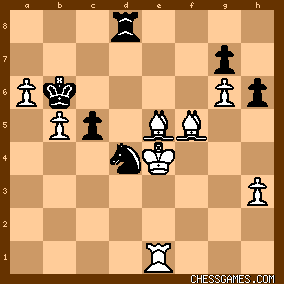
click for larger viewThis should be an easy win for White. |
|
Mar-23-12
 | | AylerKupp: The Immortal Draw (Part 5 of 8, Rybka 4.1)
Finally, let see how Rybka 4.1 evaluates the continuation from <sofouuk>'s ending position:
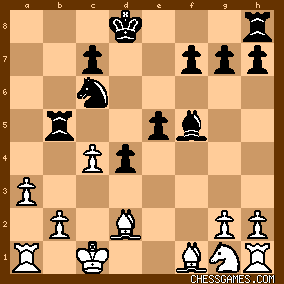
click for larger view
[+1.11], d=23: 22...Rb3(1) 23.Be2 e4(2) 24.Bd1 Rb7(3) 25.Bf4 Ke7 26.Ne2 Ra8(4) 27.b3 Be6 28.a4 f6 29.h4 Nb4 30.Rf1 Nd3+ 31.Kd2 Rd8(5) 32.a5 e3+ 33.Bxe3 dxe3+ 34.Kxe3 Nb4 35.Nd4 c5 36.Nxe6(6)

click for larger view(1) Since the rook has to move, it's best for Black to delay White's b2-b4 as long as possible. (2) This early advance of the e-pawn, unlike what the other engines suggested, is probably a good idea since it further restricts White's pieces. (3) I'm gratified to see that Rybka agrees with me and that ...Rb7 is to be preferred over Houdini's ...Rb8, and for the same reasons. ļ (4) Although here perhaps 26...Rd8 is better, protecting the d-pawn and freeing Black's knight from the need to defend it. Once Black's knight moves (say, ...Na5 and it's hard to see how the bishop for knight exchange can be prevented), then ...c5 is possible, freeing Black's other rook from the need to defend it. (5) I told you so!
(6) The situation has changed considerably. After 36...Kxe6 Black's proud passed pawn center is gone and White is a passed pawn up with a B vs. N advantage, although Black's knight will get a fine outpost on d4. So Rybka's evaluation looks correct, although this is Rybka's continuation from this position: [+1.06], d=23: 37.Bg4+ Kf7 38.Rfd1 Rxd1 39.Rxd1 Ke7 40.Kf4 Ra7 41.Re1+ Kd8 42.Ra1 Nc2 (perhaps 42...Nc6 to clarify the position on the q-side is more straightforward, but Rybka evaluated the resulting position slightly better for White at [+1.56], d=23) 43.Rd1+ Ke7 44.h5 Nd4 (and here 44...Rxa5 seems more straightforward but 45.Rd7+ Kf8 46.h6 may present insurmountable problems for Black) 45.b4 Ne6+ 46.Bxe6 Kxe6 47.bxc5 Rxa5 48.Rd5 Ra4 49.Rd4 Ra5 50.Rd6+ Ke7 51.Rd5 Ra4 52.Rd4

click for larger viewAnd this looks headed for another non-immortal draw by repetition. |
|
Mar-23-12
 | | AylerKupp: The Immortal Draw (Part 6 of 8, Eliminating ...Bxh3, part 1, Stockfish) Both Stockfish and Houdini had Black playing ...Bxh3 in response to White's Ng1-h3. This didn't make sense to me, exchanging Black's bishop for White's ill-placed knight and leading to positions somewhat advantageous for White ([+1.09] in Stockfish's case and [+1.01] in Houdini's case. Here's how Stockfish evaluated my attempt to improve on its game by 20...Bf5:

click for larger view[+1.33], d=32: 21.Bd2 Rb8+ 22.Ka2 Ra4 (maybe 22...Nb4+ ?) 23.Re1 Bc2 24.Nf2 Bb3+ 25.Kb1 Bxc4 26.Bb4+ (so maybe 18...Kd7 should have been played instead of 18...Ke7) 26...Rbxb4 27.axb4 Ba2+ 28.Kc1 Rxb4 29.Bd3 h6 30.Be4 f6 31.Bxc6 Rc4+ 32.Kd2 Rxc6 33.Nd3 Rb6 34.Ra1 Bd5 35.Rhc1 Kd6 36.Ra7 e4 37.Rcxc7 exd3 38.Rxg7 Rxb2+ 39.Kxd3 Bxg2 40.Kxd4

click for larger viewA reasonable evaluation from a material perspective since Black only has one pawn for the exchange. But starting from this position Stockfish evaluates it as only a miniscule advantage for White, [+0.20], d=32 after 40...Rxb2 41.Rxg7 Bd5 42.Rg6 Rd2+ 43.Kc3 Rxh2 44.Rxf6+ Ke5 45.Rf8 Rh3+ 46.Kb4 Rh4+ 47.Kc5 Be6 48.Rh8 Rh5 49.Re1+ Kf6+ 50.Kb4 Bf7 51.Rf1+ Kg7 52.Rb8 Rh4+ 53.Kc5 Rh5+ 54.Kc6 Bd5+ 55.Kd6 Bg2 56.Ra1 Rd5+ 57.Ke6 Rg5 58.Ra7+ Kg6 59.Rg8+ Kh5 60.Rd8 Bf3 61.Rd3 Be2 62.Rd2 Bc4+ 63.Kd6 Rg1 64.Rf2

click for larger viewHard to see how this would be anything but a draw and it seemed that way to me since 44...Ke5. I personally would have advanced the h-pawn one square where it could protect the bishop if necessary, freeing the rook and king to "dance" as much as they felt like it, but that's just a personal opinion. However, 20...Bf5 instead of 20...Bxh3 seems to lead to a drawish position. |
|
Mar-23-12
 | | AylerKupp: The Immortal Draw (Part 7 of 8, Eliminating ...Bxh3, part 2, Houdini) Let's see if I can improve on Houdini's play by 24...Rb7 and 28...Bf5:
24....Rb7 25.Bf4 d3 26.b4 Ra8 27.Kb2 Kd7 28.Nh3

click for larger view (a) [+2.93], d=25: 28...h6 28.Nf2 Bh7 29.g4 Nd8 30.Re1 Re8 31.Kd2 Rb6 32.Ba4+ c6 33.Bg3 Ra6 34.Bb3 h5 35.gxh5 f5 36.c5 Ne6 37.Bxe6+ Rxe6 38.a4 g5 39.hxg6 Bxg6 40.Bf4

click for larger viewThings don't look so great for Black. A piece down and his passed central pawns are blockaded and unable to advance. And with b4-b5 White will have 2 connected passed pawns and Black's king will be more exposed than White's. (b) [+2.37], d=26: 28...Be6 29.Kd2 Ra8 30.Ng5 f5 31.g4 g6 32.b5 Na5 33.Nxe6 Kxe6 34.Rc1 c5 35.Rg1 Rd7 36.gxf5+ gxf5 37.Rc3 Rd4 (37...Ra7, preventing 38.Rg7, might have been better) 38.Rg7 Rd7 39.Rg5 Kf6 40.Bb3 Nxb3+ 41.Rxb3 Ra4 42.Rc3 Ra8 43.b6

click for larger viewThings don't look so great for Black here either. Only one pawn for the piece, his central passed pawns are also blockaded, and White's 2 passed pawns have started their advance. And nothing can stop White's h2-h4-h5-h6 and Rg5-g7. One of White's pawns will queen. But 29...Ra8 seems odd, refusing to take advantage of the chance to advance the k-side pawns (taking the Pc4 loses after 29...Bxc4 30.Rc1 Bd5 31.Ba4 followed by piling on the pinned Nc6). So let's try 29...h6 and see if the k-side pawns can be successfully advanced. This doesn't look so successful either ([+2.93], d=25) after 29.Nf2 f5 30.g4 g6 31.Ba4 Ra8 32.gxf5 gxf5 33.Bxc6+ Kxc6 34.Rhg1 Bf7 35.Nd1 Kd7 36.Ne3 Ke6 37.Nd5 Rc8 38.Bxh6 Rh8 39.Bf4 c6 40.Ne3 Ra8 41.c5 Ra4 42.h4 Rba7 43.Nc4 R7a6 44.Raf1

click for larger viewThis looks the worst yet for Black. Not only are his passed center pawns blockaded, but his rook are immobilized, White's rooks have open files, and Black has a passed h-pawn to contend with. So it looks like (no surprise) I can't improve on Houdini's play. Therefore the attempt to improve on Black's play by not playing ...Bxg3 is inconclusive, Stockfish thinks that it can be dispensed with (leading to a draw in either case) but Houdini thinks that it is necessary to reduce Black's disadvantage. |
|
Mar-23-12
 | | AylerKupp: The Immortal Draw (Part 8 of 8, My Preliminary (!) Conclusions) Phew! It looks like the score is 1-2-1 in terms of who gets the advantage after 11.Kb5. Houdini evaluates the resulting positions as advantageous for White but not necessarily winning, although it indicates that White's advantage increases as the game goes on. Stockfish and Rybka do the same as Houdini initially but their evaluations later peter out to positions with even chances. Spike evaluates the resulting positions as advantageous for Black. And, of course, the play isn't forced; these lines are only indicative of what COULD happen, not necessarily what WOULD happen and I noticed many opportunities for both sides (mostly Black) to save a tempo or two which might change the engine evaluations. And I'm sure that neither Hamppe nor Meitner fully appreciated how complex this game really was or could have been. So I would say that the Immortal Draw has not (yet) been debunked. What do you all think? Black has many opportunities to (almost) equalize and possibly win (Spike) and there is no apparent forced win for White even though some of the lines lean that way. And, of course, there were many possibilities that I didn't get a chance to look at. One thing does seem sure to me, Black's queen sac 9...Qxa4+ looks sound (or at least not unsound) since White must give the queen back to avoid getting mated and then the game can get really complicated. So maybe <chessgames.com> is right and the only way to possibly settle this question is to make it the subject of a Thematic Game Challenge and start with the position after 10...Nc5+. This would allow for much more analysis in this very complicated and fascinating game. And I hope that <sofouuk> is not mad at me for contradicting him. |
|
| Apr-15-12 | | Arcturus: Must uf been a good game for the spectators a'swell. |
|
| Jun-29-12 | | reisanibal: Kibitzing used to be fun. But then they started to post those boring analyses of their computers. By the way, a very good try by black. Beautiful game. |
|
| Aug-09-12 | | kangaroo13: bc6 does not make sense |
|
| Nov-13-12 | | ajax333221: <kangaroo13> it does, the king is trapped and if he doesn't do anything b6 is checkmate, he must free the b5 square to escape. Bc6 is the only move that don't generate a mate in 2 or 4 |
|
Mar-12-13
 | | AylerKupp: <<reisanibal> Kibitzing used to be fun. But then they started to post those boring analyses of their computers.> Would it be more fun if instead we posted boring analyses by humans? |
|
| Feb-08-14 | | Lovuschka: What connects the Viennese opening in chess with nuclear fission? The far from obvious answer is: Exactly this game, the immortal draw. - With the White pieces, we have Carl Hamppe, a Swiss-born official in the Austrian ministry of finances, inventor of the Viennese opening 1.e4 e5 2.Sc3, planning 3.f4. - With the Black pieces, we have Philipp Meitner, a jewish Viennese lawyer, grandfather of Otto Frisch, father of (E-)Lise Meitner, who participated at the discovery of nuclear fission. This is a nice example why the story behind a game is sometimes as interesting as the game itself. |
|
| Dec-15-14 | | GoldenBird: 9....Qxa4!!! was an incredible move. And black probably thought he had the game clinched, but Hamppe found 13. Bc6!, the only move to draw |
|
Jun-07-15
 | | Phony Benoni: Good! I was rooting for this one to come up! |
|
Jun-07-15
 | | Penguincw: Haha, another draw! At this point, I'm quite happy the GOTDs are a draw (not sure why, but I'll take it). Let's hope for another draw tomorrow! |
|
Jun-07-15
 | | offramp: We will only know if this pun is any good when the earth explodes. |
|
 |
 |
|
< Earlier Kibitzing · PAGE 9 OF 12 ·
Later Kibitzing> |
|
|
|





